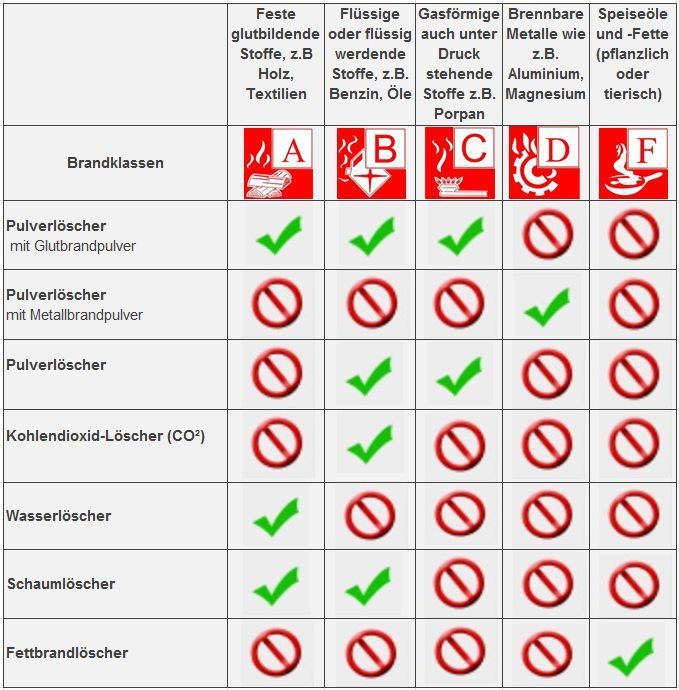Fire Class A: All solid materials that occur primarily in nature fall into Fire Class A. These materials usually burn with embers, so an extinguishing agent must be used that not only extinguishes the flames but also extinguishes the embers. Water, or fire extinguishers filled with foam or powder, are ideal for this purpose. However, powder extinguishers should only be used as ABC extinguishers, as they contain an ember-extinguishing powder. Fire Class A includes materials such as wood, coal, textiles, paper, some plastics, hay, straw, and fibers.
Fire class



Fire Class B Fire Class B includes all liquid, flammable materials and materials that liquefy when exposed to heat. Examples of liquid materials include gasoline, oils, greases, paints, varnishes, and alcohol. Materials that melt and liquefy when exposed to heat include plastics such as PVC, wax, tar, resin, and numerous other synthetic materials. Materials in Fire Class B burn exclusively with flames and do not produce embers. With these materials, care must be taken to ensure that they are never extinguished with water in the event of a fire! The water would evaporate, and the burning liquid would cause an explosion. Materials in Fire Class B are smothered by the extinguishing agent. A fire blanket, foam fire extinguisher, ABC fire extinguisher, BC powder fire extinguisher, or CO2 (carbon dioxide) extinguisher can be used for this purpose.

Fire Class C: All flammable gases such as propane, methane, town gas, natural gas, butane, acetylene, and hydrogen fall under fire class C. These gases do not produce embers; instead, they burn only with flames. Gas fires cannot be extinguished with water, foam, or carbon dioxide (CO2) and are therefore completely unsuitable as extinguishing agents. Fire extinguishers with ABC powder and BC powder are suitable extinguishing agents.

Class D fires are very rare in everyday life, as they involve fires involving flammable metals such as aluminum, magnesium, sodium, potassium, or lithium. These metals burn exclusively at very high temperatures of well over 1000°C and are considered very difficult to extinguish. Class D metal fires must never be extinguished with water, as the high temperatures would cause the water to split into steam and oxygen, resulting in the formation of oxyhydrogen gas with a high risk of explosion. Metal fires are extinguished exclusively with special metal fire powder, dry sand, dry cement powder, or dry road salt or livestock salt.

Fire class F Fires involving cooking fats and oils are classified as class F fires and are typically common in everyday kitchens. Due to the high risk involved, fire class F was included in the classification of the European standard EN 2 in 2005. It can happen very quickly and the frying pan full of hot cooking oil is forgotten on the stove for a moment. Overheated cooking fats and oil pose a high risk of reignition, which often leads to serious injuries. Grease fires must never be extinguished with water, as water is lighter than burning fat. If an attempt is made to extinguish a fire with water, the extinguishing water would quickly sink into the burning fat and evaporate. The resulting steam would suddenly shoot upwards, sweeping the hot fat with it, creating a flash flame. Grease fires are generally extinguished; the most effective method is to quickly cover them with a metal lid. The hotplate should be turned off immediately and the fire source moved away from the hob, if possible. Fire blankets are only partially suitable for extinguishing grease fires, as are powder fire extinguishers and CO2 extinguishers. Grease fire extinguishers, which are filled with a special extinguishing agent that saponifies the burning liquid, are the most suitable.
All rights reserved | Hermsdorf Fire Department


